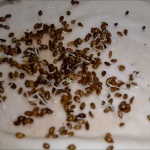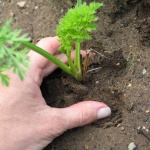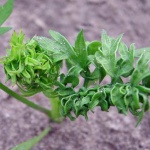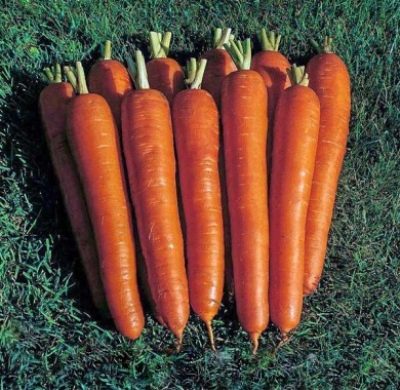
- Year of approval: 2006
- Appointment: for fresh consumption, for canning, for making juice
- Leaf rosette shape: semi-spreading
- Leaves: long, green, with fine to medium dissection
- Weight, g: 80-190
- The form : cylindrical with a slightly pointed tip
- Taste qualities: good ones
- Composition : dry matter 12.6-16.0%, total sugar 6.6-9.0%
- Ripening terms: late ripening
- Growing regions: Central
Every vegetable grower dreams of growing tasty and juicy carrots on the garden ridge, which will delight with fresh taste and aroma all winter. To do this, you need to choose a variety with long-term keeping quality and excellent taste. These include the late-ripening variety Imperator, bred relatively recently by Russian scientists.
Breeding history
Carrots with the majestic name Emperor were bred by a group of breeders of the Poisk agrofirm in 2003. The vegetable crop was added to the ranks of the State Register of approved for use in 2006. A variety was created for cultivation in the Central region. You can grow a vegetable both in a small garden bed and in farm fields.
Description of the variety
The emperor is a plant with a powerful, erect rosette, characterized by semi-spreading foliage. The plant's tops are quite high - 35-45 cm. The leaves, evenly colored in bright green, are endowed with an average degree of dissection. Sometimes the leaf plate grows pinnately dissected. The foliage does not have a pronounced aroma. Carrots belong to the Berlikum cultivar.
Ripe root crops protrude slightly above the soil surface, which greatly simplifies the harvesting process.
Characteristics of the appearance of the plant and root crops
The emperor belongs to the class of large-fruited. The specimens grow neat and aligned, which attracts farmers who grow vegetables for commercial purposes. The average weight of a vegetable is 80-190 grams. It is also worth highlighting that the roots are long - 25-30 cm, and the diameter is up to 5 cm. The shape of the fruits is standard - cylindrical, with a slightly pointed "nose". The skin of the tubers is thin, shiny, without noticeable eyes and filamentous roots on the surface. The ripe vegetable acquires a uniform red-orange color.
The shelf life of vegetables reaches 8-9 months if the right conditions are provided - dryness, temperature + 2 ... 4 degrees, ventilation and darkness. Root crops tolerate transportation well, without losing marketability and taste.
Purpose and taste of tubers
This variety impresses with its excellent taste. The red-orange pulp is characterized by a firm, fleshy, crunchy and very juicy structure without fibrillation or voids. The taste is balanced - sweetness and sugariness are combined with a bright carrot aroma. The core inside the vegetable is very thin, not differing in color and taste. Carrot pulp contains about 11% sugar and more than 20% carotene. The variety is ideal for dietary and baby food.
Ripe vegetables have a wide range of uses in cooking - carrots are eaten fresh, frozen, added to hot and cold dishes, used in canning, pickled, processed into puree and juices. In addition, the variety is suitable for harvesting for the winter.
Maturation
The emperor is a member of the late ripening class.More than 4 months pass from the emergence of mass shoots to the ripening of root crops in the garden - 120-135 days. Partial digging of young root crops is allowed in August, and mass harvesting occurs in September-October.
Yield
The variety is claimed to be high yielding. If you follow all the agrotechnical recommendations, then you can count on an excellent harvest - on average 158-290 centners / ha of plantings. When planting on garden ridges, on average, up to 5.5-8 kg are obtained from 1 m2 of plantings.
Growing and care
A vegetable crop is planted in the first half of May, when the soil warms up enough and the temperature regime stabilizes. For this, elongated grooves up to 3 cm deep are prepared on the site, where pre-treated carrot seeds are sown. The distance between the rows should be at least 18-20 cm. Sowing is carried out according to the 5x18-20 cm scheme. The ridge where onions, cucumbers, early potatoes or tomatoes previously grew is considered the best place for planting.
It is also worth noting that the variety is suitable for winter sowing. Carrot seeds are sown at the end of October, when the air temperature is kept at + 4 ... 5 degrees.
Caring for a vegetable crop does not require special skills, since it consists of basic activities. So, the Emperor's carrots need regular weekly watering (a drip system is recommended), top dressing with potassium-phosphorus fertilizers 2-3 times per season, loosening and weeding of the soil, double thinning of plants, keeping a distance between plantings of 4-5 cm, prevention of diseases and pest infestations ...
Before harvesting, it is recommended to water the beds abundantly, which will allow you to easily remove the ripened roots from the soil without violating their integrity.
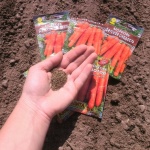
Carrots are one of the most unpretentious crops in terms of growing conditions; they can endure a short drought and a short cold snap. However, to get tasty and large root crops, you should adhere to the basic rules for planting carrots.


Soil requirements
Vegetable crops are demanding on the structure of the soil. The vegetable grows comfortably in light loamy and sandy loamy soils with good air permeability, rich in useful components. In addition, carrots do not tolerate acidic and waterlogged soils, in which they simply begin to hurt.
Required climatic conditions
The variety is stress-resistant, therefore it easily tolerates temperature fluctuations, excessive moisture and short-term shade. Despite this, it is better to choose a sunny place for planting, where it is light and warm. Experienced vegetable growers recommend planting Emperor carrots on small hills, where there is no excessive stagnation of water.
Disease and pest resistance
A clear advantage of the variety is its resistance to a number of diseases. It is extremely rare for a vegetable to undergo powdery mildew and cercosporosis. A plant can be attacked by a carrot moth, a bear and a wireworm, which will help to get rid of preventive spraying with special preparations.
The variety is distinguished by its high resistance to root cracking and shooting (flowering).
Bordeaux liquid and fungicides will help fight diseases. Experienced gardeners, in order to prevent the invasions of the bear and wireworm, apply pesticides to the soil when sowing seeds.

Carrots grow in almost any garden. There is an opinion that this culture is very resistant to all kinds of diseases and pests, but this is not the case. Without proper care, carrots become susceptible to all kinds of infections and are affected by harmful insects.


